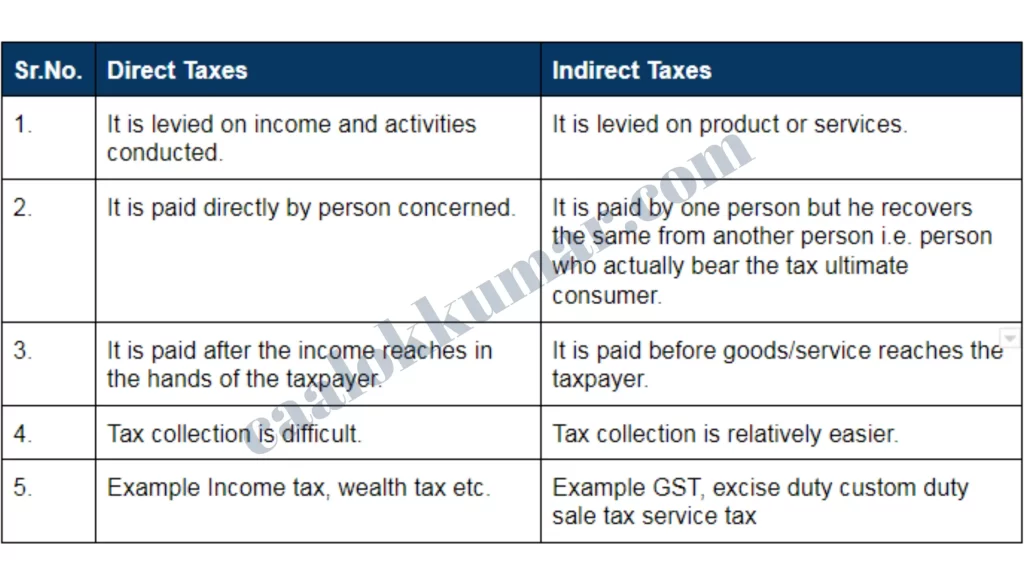In India, taxes are broadly classified into two categories: direct taxes and indirect taxes. Let’s break down the differences in simple terms:
Direct Taxes:
- Definition: Direct taxes are paid directly to the government by the individual or organization on whom it is imposed.
- Impact: The burden of direct taxes cannot be shifted to someone else. The person who pays the tax bears the burden.
Examples:
- Income Tax: Charged on the income of individuals and businesses. For example, if you earn a salary, a portion of it is paid as income tax.
- Corporate Tax: Levied on the profits earned by companies.
- Capital Gains Tax: Imposed on the profits made from selling assets like property or stocks.
- Wealth Tax: Based on the value of property or wealth owned by an individual.
Indirect Taxes:
- Definition: Indirect taxes are levied on goods and services rather than on income or profits.
- Impact: The burden of indirect taxes can be passed on to others. For instance, a manufacturer of goods can pass on the tax burden to consumers by increasing the price of the product.
Examples:
- Goods and Services Tax (GST): Applied to the sale of goods and services. This is a comprehensive tax that has replaced many other indirect taxes in India, like VAT, service tax, etc.
- Excise Duty: Charged on goods manufactured within the country.
- Customs Duty: Levied on goods imported into the country.
- Value Added Tax (VAT): Before GST, VAT was charged on the sale of goods within states.
Key Differences:
- Point of Impact: Direct taxes affect the individual or entity that pays them directly, while indirect taxes affect consumers who buy goods and services.
- Evasion: Direct taxes are harder to evade as they are linked to the income or assets of an individual or entity, whereas indirect taxes are included in the price of goods and services and hence are collected at the point of sale.
- Progressiveness: Direct taxes are often progressive, meaning the higher the income or profit, the higher the tax rate. Indirect taxes are generally the same rate for everyone, regardless of income level.
In summary, direct taxes are paid based on income or wealth and are borne by the person on whom they are imposed, while indirect taxes are included in the price of goods and services and are borne by the end consumers.
As of the financial year 2023, the collection of direct and indirect taxes in India presents a significant contribution to the country’s revenue. Here’s an overview based on the latest available statistics:
Direct Taxes
- Proportion of Total Tax Collection: Direct taxes accounted for 51.5% of the total central tax collection.
- Gross Collection: The gross collection of Direct Taxes for the Financial Year 2023-24 (as of September 16, 2023) stood at Rs. 9,87,061 crore, representing an 18.29% increase compared to the corresponding period of the previous financial year.
- Net Collection: As of June 17, 2023, the net collections of Direct Taxes were Rs. 3,79,760 crore, an 11.18% increase from the previous financial year.
- Previous Year Comparison: For the Financial Year 2022-23, the net collections were at Rs. 16.61 lakh crore, showing a 17.63% increase from the Financial Year 2021-22.
Indirect Taxes
- Proportion of Total Tax Collection: Indirect taxes constituted 48.5% of the total central tax collection.
- Growth Rate: Indirect tax collections grew by 14% year-on-year in the April-August quarter of FY23. This growth rate was significantly over the required rate of 3.5% to achieve the full-year target, with high GST collections contributing substantially to this increase.
- Expected Surpassing of Target: The increase in indirect tax collections was expected to surpass the FY23 target of INR 13.38 trillion by a considerable margin.
- Previous Year Collections: In FY22, despite a cut in excise duty on petrol and diesel, collections for indirect taxes grew by 20% year-on-year to INR 12.93 trillion, demonstrating the tax buoyancy effect.
These figures illustrate the substantial growth in both direct and indirect tax collections in India, reflecting the country’s evolving economic landscape and effective tax collection mechanisms. The balanced contribution of both direct and indirect taxes highlights the comprehensive nature of India’s taxation system.
Read here:-



